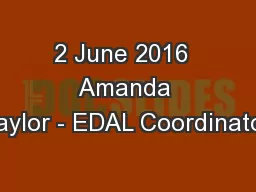PPT-2 June 2016 Amanda Taylor - EDAL Coordinator
Author : cheryl-pisano | Published Date : 2018-10-28
The reception of refugees and asylum seekers in Europe in 2015 Snapshot of numbers 02062016 Table 3 Unaccompanied asylum seeking children in selected AIDA countries
Presentation Embed Code
Download Presentation
Download Presentation The PPT/PDF document "2 June 2016 Amanda Taylor - EDAL Coordi..." is the property of its rightful owner. Permission is granted to download and print the materials on this website for personal, non-commercial use only, and to display it on your personal computer provided you do not modify the materials and that you retain all copyright notices contained in the materials. By downloading content from our website, you accept the terms of this agreement.
2 June 2016 Amanda Taylor - EDAL Coordinator: Transcript
Download Rules Of Document
"2 June 2016 Amanda Taylor - EDAL Coordinator"The content belongs to its owner. You may download and print it for personal use, without modification, and keep all copyright notices. By downloading, you agree to these terms.
Related Documents














